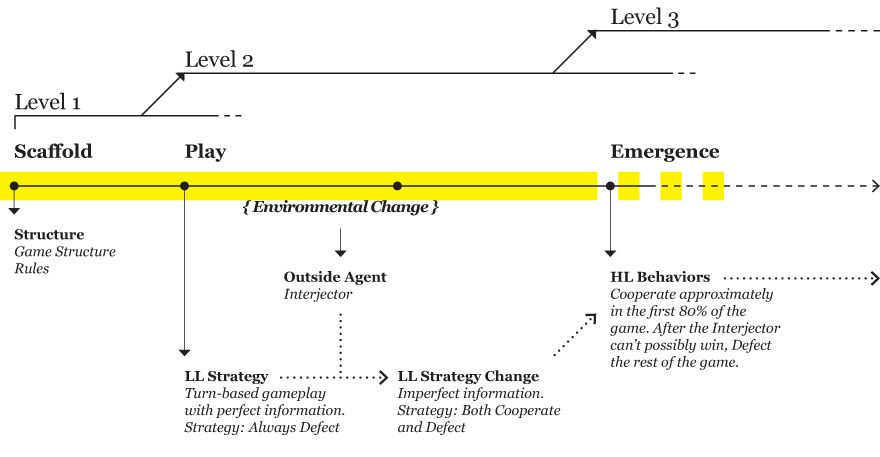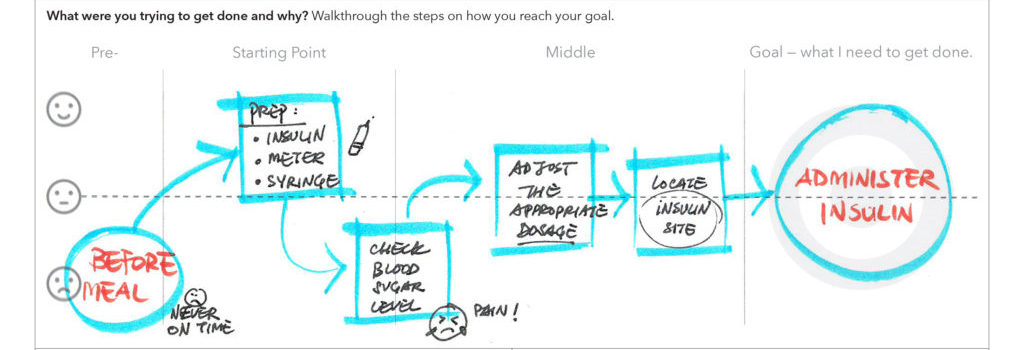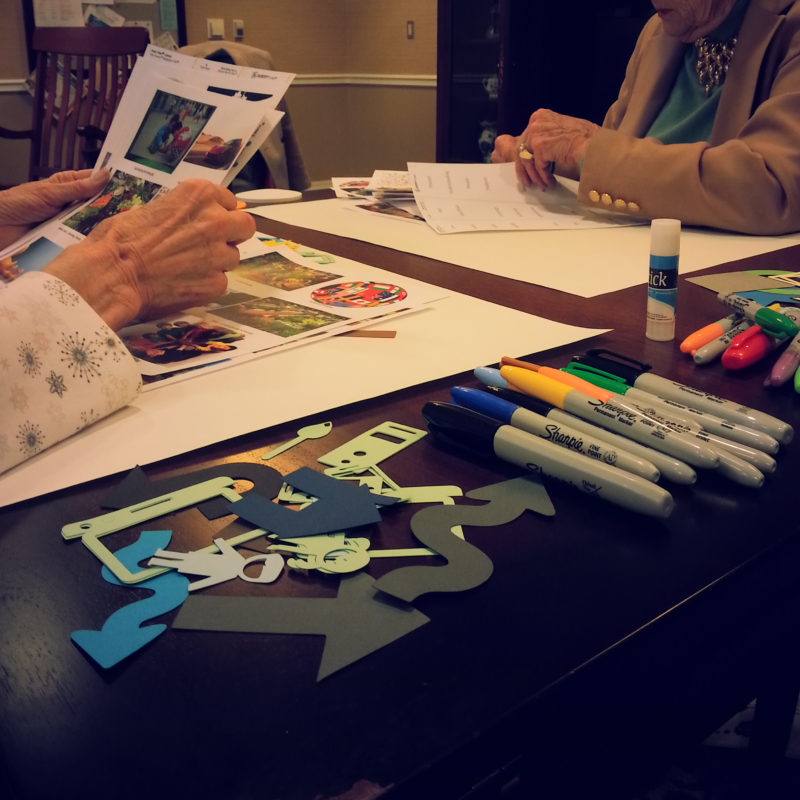TLDR: The main idea of this study is to understand how human behavior change just by modifying certain rules in any given structure. Dots & Boxes was picked as a case study because of its simplicity. The result indicates that adding a component (an interjector) and a new rule (disrupt square completion when players connects ONLY with his/her own color at nth turn), would change player behaviors from purely competitive to collaborative.
TEAM
Darwin
RESPONSIBILITIES
• Design Research Methods
• Conduct Experiment
• Organize Data
• Analysis
OBJECTIVE
The tasks of this research exploration consisted of mapping the location of people and noise concentration (whenever possible) and measuring overall levels of noise over time. The purpose of this study, however, was not to look at noise level as the emergent phenomena. Instead, it was an attempt to sketch out what possible rules and behaviors may influence noise in public spaces. The observational research was conducted at both Heirloom Cafe at Wexner Center and KSA Cafe at Knowlton School of Architecture at The Ohio State University.
BACKGROUND
Dots & Boxes is a game where two players (P1 and P2) take turns to connect horizontally or vertically two adjacent dots by making a line. When a player completes a square, the player claims that square as his/her territory and gets another turn. The player with the most squares claimed would be the winner. The example shown below is an interactive game that was played from Thomas S. Ferguson’s website of the Mathematics Department at UCLA (dots&boxes, 2003).
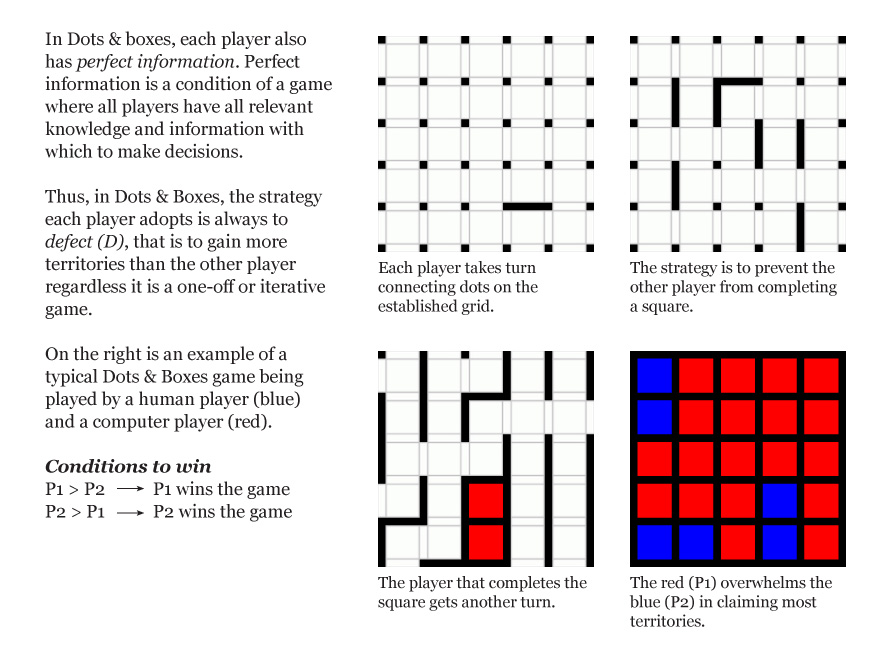
A game played between two players: human (blue) vs computer (red).
CONCEPTUAL PRELIMINARIES
Because of the rigidity of the rules of Dots & Boxes, while the visual pattern can be changing in different games, it tells very little about the behavior change of the players. In Dots & boxes, each player also has perfect information. Perfect information is a condition of a game where all players have all the relevant knowledge and information with which to make decisions. Thus, in Dots & Boxes, the strategy each player adopts is always to defect, that is to gain more territories than the other player regardless of whether it is a one-off or iterative game. In a very peculiar instance, for example in a 4 by 4 grids game, there may be a condition where the outcome results in a draw (i.e., both players occupy the same number of boxes). However, the strategy of both players would still be to outperform each other. In the example above, the only possible outcome of 5 by 5 grids is one winner:
P1 > P2 → P1 wins the game, or
P2 > P1 → P2 wins the game.
Thus, P1 or P2 will win, but they both cannot win at the same time. In the attempt to see behavioral change, the rules of the game were somewhat modified. An outside/external agent was included as a kind of environmental feedback — an Interjector (I) — for the players to respond to. A point system was introduced in which monopolized boxes (by one player) got 2 points and shared boxes (by two players) meant each player got 1 point. The rules were still turn-based and the underlying structure of the game remained the same. Based on those modification, the conditions to win the game became more varied:
P1 > (P2 v I) → P1 wins the game, or
P2 > (P1 v I) → P2 wins the game, or
I > (P1 v P2) → I wins the game, or
I > (P1 & P2) → I wins the game.

I came up with a modified rules for Dots & Boxes, by introducing an “external agent”, I called the Interjector (I). A slightly different kinds of point system was also introduced.
EXPERIMENT
Two participants volunteered to test-play the modified game with the rules outlined as above. The game was still turn-based between two players with the addition of a referee playing as the Interjector. However, the players did not know when and how the Interjector would come in to interject their game: i.e., at every fourth turn when one player connects ONLY with his/her own color continuously and a square is not formed. The modified game was played twice in order to give both players a chance to change their strategies during the game. In the first game, it was very difficult for the players be able to win individually, because the Interjector kept interjecting both players as they competed with each other (defect strategy) — neither player had the chance to complete their own box. Both players had no idea how precisely the Interjector behaved. Even though both players shared all of the boxes, it was not a cooperative behavior as evident from the amount of areas the Interjector was able to claim.

The first game of modified Dots & Boxes.
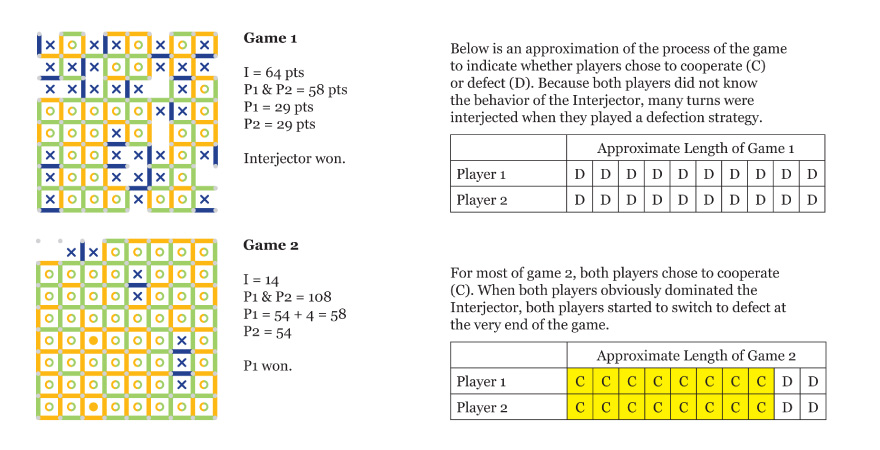
After having a sense of the rule of the modified game—players switch to cooperative strategy.
In the second game, both players started to have a clearer sense of the behavior of the Interjector learned from the experience in the first game. Thus, they changed the strategy from defection to cooperation. By understanding the behavior of the Interjector, both players’ cooperation dominated the Interjector’s gameplay. For the most of the game, the players’ cooperation achieved equilibrium (highlighted in yellow), not only because they were gaining points, but they were also stopping the Interjector.
However, near the end of the game when it was obvious that the Interjector couldn’t possibly win the game, both players switched to defection. When both players defected, the player with better moves won the game (P1). Even though both players discovered the gameplay of the Interjector, the modified rules turned a game of perfect information into a game of imperfect information because a player did not have an idea precisely when the other player was going to cooperate or defect.
CONCLUSION
Even without changing the core structure of the game, by modifying the rules slightly, not only do we see that the players changed their behavior drastically (when they realized the behavior of the Interjector), but a complex behavior also appeared: cooperate first to deal with the Interjector, and when the conditions are met where the Interjector cannot possibly win, defect! The cooperative behaviors emerged from a non-cooperative game. The diagram below shows that the environmental change (interjector comes into play) changed player’s strategy. The culmination of the different choices of players’ strategies was expressed in the overall gameplay narrative.
